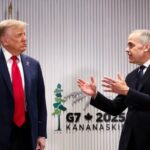Energy News Beat
What Powell Said about rate hikes, no rate cuts, rate cuts, and the QT slowdown while getting rid of MBS entirely.
By Wolf Richter for WOLF STREET.
“Hike” and “rate hike” were mentioned 8 times by reporters and by Powell during the FOMC’s post-meeting press conference today. Those terms weren’t mentioned at all in the press conferences during Rate-Cut Mania, which were all about “rate cuts,” how many and when.
Powell was obviously unenthusiastic about rate hikes, and thought it “unlikely that the next policy rate move will be a hike” – “our policy focus is really how long to keep policy restrictive,” he said. But rate hikes weren’t even on the table before, so that alone was a big shift, from a bunch of rate cuts to having to deal with the possibility of a rate hike. One step at a time.
What would it take for the Fed to hike rates?
“We need to see persuasive evidence that our policy stance is not sufficiently restrictive to bring inflation down to 2%,” he said. “We look at the totality of the data to answer that question. That would include inflation. Inflation expectations and all the other data, too.”
The Fed could hike rates “if we were to come to that conclusion that policy wasn’t tight enough to achieve that, so it would be the totality of all the things we’re looking at; it could be [inflation] expectations, it could be a combination of things. If we reach that conclusion – and we don’t see evidence supporting that conclusion – that’s what it would take for us to take that step,” he said.
“So, if we were to conclude that policy is not sufficiently restrictive to bring inflation sustainably to under 2%, then that would be what it would take for us to want to increase rates,” he said.
Is there a timeframe of persistent inflation that would trigger a rate hike? “These are going to be judgment calls. Clearly restrictive monetary policy needs more time to do its job. That’s pretty clear based on what we’re seeing. How long that will take and how patient we should be depends on the totality of the data and how the outlook evolves,” he said.
Was there a discussion at the meeting about a rate hike? “The policy focus has been on what to do about holding the current level of restriction. That’s where the policy discussion was in the meeting,” he said.
Oh deary, where did my rate cuts go?
“So, let me address cuts,” Powell said. “Obviously, our decisions we make on our policy rate will depend on the incoming data, how the outlook is evolving, and the balance of risks, as always. We’ll look at the totality of the data. We think that policy is well positioned to address different paths that the economy might take.”
“We don’t think it would be appropriate to dial back our restrictive policy stance until we’ve gained greater confidence that inflation is moving down sustainably to 2%,” he said.
“If we had a path where inflation proves more persistent than expected, and where the labor market remains strong, but inflation is moving sideways, we’re not gaining greater confidence. That would be a case in which it could be appropriate to hold off on rate cuts.”
“There are other paths that the economy could take which would cause us to want to consider rate cuts.” One path “would be that we do gain greater confidence if inflation is moving sustainably down to 2%,” he said. “Another path could be an unexpected weakening in the labor market, for example.”
“For us to begin to reduce policy restriction, we want to be confident that inflation is moving sustainably down to 2%. For sure, one of the things we would be looking at is the performance of inflation. We would be looking at inflation expectations. We would be looking at the whole story. Clearly, incoming inflation data would be at the very heart of that decision.”
Wait-and-see is now entrenched?
“My colleagues and I today have said that we didn’t see progress [on inflation] in the first quarter. And I’ve said that it appears then that it’s going to take longer for us to reach that point of confidence. I don’t know how long it will take. I can just say that when we get that confidence, then rate cuts will be in scope. And I don’t know exactly when that will be,” he said.
“What do we now see in the first quarter? Strong economic activity. We see a strong labor market. We see inflation. We see three [bad] inflation readings. I think you’re at a point there where you should take some signal. We don’t like to react to one or two months of data. But this is a full quarter. We are taking signal. And the signal we’re taking is it’s likely to take longer for us to gain confidence that we’re on a sustainable path to 2% inflation. That’s the signal we’re taking,” he said.
“My expectation is that we will, over the course of this year, see inflation move back down. That’s my forecast. But my confidence in that is lower than it was because of the data we’ve seen,” he said.
“We actually have the luxury of having strong growth and a strong labor market, very low unemployment, high job creation, and all of that. And we can be patient. We will be careful and cautious, as we approach the decision to cut rates,” he said.
What’s the chance of no rate cuts?
“I don’t have a probability estimate for you. But all I can say is that we didn’t think it would be appropriate to cut until we were more confident that inflation was moving sustainably at 2%. Our confidence in that didn’t increase in the first quarter. And, in fact, what really happened was we came to the view that it will take longer to get that confidence.”
“But there are paths to not cutting. And there are paths to cutting. It’s really going to depend on the data.
QT slowdown to avoid accidents that could stop it prematurely.
“The decision to slow the pace of runoff does not mean that our balance sheet will ultimately shrink by less than it would otherwise, but rather allows us to approach its ultimate level more gradually,” Powell said.
“In particular, slowing the pace of runoff will help ensure a smooth transition, reducing the possibility that money markets experience stress, and thereby facilitating the ongoing decline in our securities holdings that are consistent with reaching the appropriate level of ample reserves,” he said. The Fed has already shed over $1.5 trillion in assets since it started QT in July 2022.
Why even slow QT? “It’s really to ensure that the process of shrinking the balance sheet down to where we want to get it is a smooth one and doesn’t wind up with financial market turmoil, the way it did the last time we did this,” Powell said in reference to the repo market blowout in the second half of 2019, which caused the Fed to step back in with large-scale repo operations that quickly undid a big part of QT-1. And that’s to be avoided this time.
The FOMC’s statement and Implementation Notes today already outlined the basics of the QT slowdown:
Starts in June
Cap for Treasury runoff reduced to $25 billion from $60 billion
Cap for MBS runoff stayed at $35 billion
If MBS run off faster than $35 billion a month, then the excess will be replaced with Treasury securities, and not MBS.
Getting rid of MBS entirely. What Powell added in the press conference was the Fed’s intention “to hold primarily Treasury securities in the longer run,” meaning they want to get rid of MBS entirely. Powell cited this intention as the reason for not reducing the runoff rate of MBS, and for not replacing any excess MBS runoff over the $35 billion cap with MBS, but with Treasury securities.
This unchanged cap also means that QT will speed up when the housing market unfreezes and sales volume goes back to more normal levels, which would trigger a much faster rate of mortgage payoffs, which would trigger a much faster pace of passthrough principal payments to holders of MBS, such as the Fed. And passthrough principal payments being the primary way in which MBS come off the balance sheet, it would speed up QT, and could push QT to a maximum pace of $60 billion a month.
Enjoy reading WOLF STREET and want to support it? You can donate. I appreciate it immensely. Click on the beer and iced-tea mug to find out how:
Would you like to be notified via email when WOLF STREET publishes a new article? Sign up here.
The post Oh Deary, Where Did my Rate Cuts Go? Fed’s Wait-and-See Now Entrenched? And Suddenly Lots of Talk about “Rate Hikes” appeared first on Energy News Beat.








